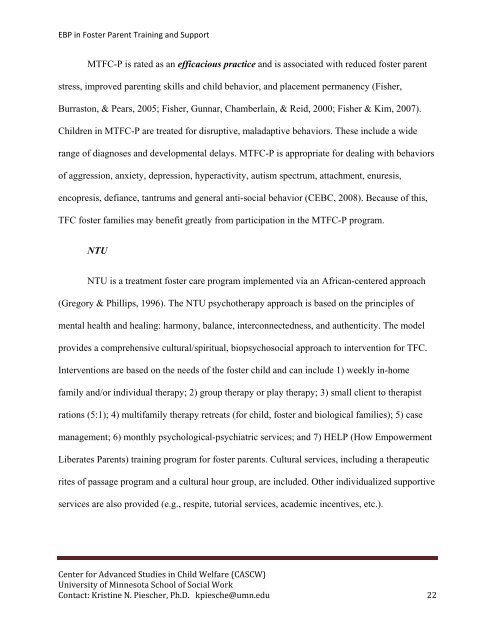Evidence-Based Practice in Foster Parent Training and Support ...
Evidence-Based Practice in Foster Parent Training and Support ...
Evidence-Based Practice in Foster Parent Training and Support ...
Create successful ePaper yourself
Turn your PDF publications into a flip-book with our unique Google optimized e-Paper software.
EBP <strong>in</strong> <strong>Foster</strong> <strong>Parent</strong> Tra<strong>in</strong><strong>in</strong>g <strong>and</strong> <strong>Support</strong>MTFC-P is rated as an efficacious practice <strong>and</strong> is associated with reduced foster parentstress, improved parent<strong>in</strong>g skills <strong>and</strong> child behavior, <strong>and</strong> placement permanency (Fisher,Burraston, & Pears, 2005; Fisher, Gunnar, Chamberla<strong>in</strong>, & Reid, 2000; Fisher & Kim, 2007).Children <strong>in</strong> MTFC-P are treated for disruptive, maladaptive behaviors. These <strong>in</strong>clude a widerange of diagnoses <strong>and</strong> developmental delays. MTFC-P is appropriate for deal<strong>in</strong>g with behaviorsof aggression, anxiety, depression, hyperactivity, autism spectrum, attachment, enuresis,encopresis, defiance, tantrums <strong>and</strong> general anti-social behavior (CEBC, 2008). Because of this,TFC foster families may benefit greatly from participation <strong>in</strong> the MTFC-P program.NTUNTU is a treatment foster care program implemented via an African-centered approach(Gregory & Phillips, 1996). The NTU psychotherapy approach is based on the pr<strong>in</strong>ciples ofmental health <strong>and</strong> heal<strong>in</strong>g: harmony, balance, <strong>in</strong>terconnectedness, <strong>and</strong> authenticity. The modelprovides a comprehensive cultural/spiritual, biopsychosocial approach to <strong>in</strong>tervention for TFC.Interventions are based on the needs of the foster child <strong>and</strong> can <strong>in</strong>clude 1) weekly <strong>in</strong>-homefamily <strong>and</strong>/or <strong>in</strong>dividual therapy; 2) group therapy or play therapy; 3) small client to therapistrations (5:1); 4) multifamily therapy retreats (for child, foster <strong>and</strong> biological families); 5) casemanagement; 6) monthly psychological-psychiatric services; <strong>and</strong> 7) HELP (How EmpowermentLiberates <strong>Parent</strong>s) tra<strong>in</strong><strong>in</strong>g program for foster parents. Cultural services, <strong>in</strong>clud<strong>in</strong>g a therapeuticrites of passage program <strong>and</strong> a cultural hour group, are <strong>in</strong>cluded. Other <strong>in</strong>dividualized supportiveservices are also provided (e.g., respite, tutorial services, academic <strong>in</strong>centives, etc.).Center for Advanced Studies <strong>in</strong> Child Welfare (CASCW)University of M<strong>in</strong>nesota School of Social WorkContact: Krist<strong>in</strong>e N. Piescher, Ph.D. kpiesche@umn.edu 22
















